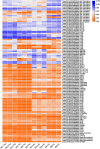Impact of "Green Revolution" gene Rht-B1b on coleoptile length of wheat
- PMID: 36938052
- PMCID: PMC10017974
- DOI: 10.3389/fpls.2023.1147019
Impact of "Green Revolution" gene Rht-B1b on coleoptile length of wheat
Abstract
Wheat coleoptile is a sheath-like structure that helps to deliver the first leaf from embryo to the soil surface. Here, a RIL population consisting of 245 lines derived from Zhou 8425B × Chinese Spring cross was genotyped by the high-density Illumina iSelect 90K assay for coleoptile length (CL) QTL mapping. Three QTL for CL were mapped on chromosomes 2BL, 4BS and 4DS. Of them, two major QTL QCL.qau-4BS and QCL.qau-4DS were detected, which could explain 9.1%-22.2% of the phenotypic variances across environments on Rht-B1 and Rht-D1 loci, respectively. Several studies have reported that Rht-B1b may reduce the length of wheat CL but no study has been carried out at molecular level. In order to verify that the Rht-B1 gene is the functional gene for the 4B QTL, an overexpression line Rht-B1b-OE and a CRISPR/SpCas9 line Rht-B1b-KO were studied. The results showed that Rht-B1b overexpression could reduce the CL, while loss-of-function of Rht-B1b would increase the CL relative to that of the null transgenic plants (TNL). To dissect the underlying regulatory mechanism of Rht-B1b on CL, comparative RNA-Seq was conducted between Rht-B1b-OE and TNL. Transcriptome profiles revealed a few key pathways involving the function of Rht-B1b in coleoptile development, including phytohormones, circadian rhythm and starch and sucrose metabolism. Our findings may facilitate wheat breeding for longer coleoptiles to improve seedling early vigor for better penetration through the soil crust in arid regions.
Keywords: QTL; Rht-B1b; coleoptile length; transcriptome; wheat.
Copyright © 2023 Xu, Hao, Yang, Lv, Qin, Wang, Jia, Liu, Dai, Zeng, Zhang, He, Xia, Cao and Ma.
Conflict of interest statement
The authors declare that the research was conducted in the absence of any commercial or financial relationships that could be construed as a potential conflict of interest.
Figures




Similar articles
-
Phenotypic and transcriptomic characterization of a wheat tall mutant carrying an induced mutation in the C-terminal PFYRE motif of RHT-B1b.BMC Plant Biol. 2018 Oct 22;18(1):253. doi: 10.1186/s12870-018-1465-4. BMC Plant Biol. 2018. PMID: 30348083 Free PMC article.
-
Molecular mapping of genes for Coleoptile growth in bread wheat (Triticum aestivum L.).Theor Appl Genet. 2007 May;114(7):1173-83. doi: 10.1007/s00122-007-0509-1. Epub 2007 Feb 9. Theor Appl Genet. 2007. PMID: 17294164
-
Use of a large multiparent wheat mapping population in genomic dissection of coleoptile and seedling growth.Plant Biotechnol J. 2014 Feb;12(2):219-30. doi: 10.1111/pbi.12130. Epub 2013 Oct 24. Plant Biotechnol J. 2014. PMID: 24151921
-
Genome-wide association study reveals genetic architecture of coleoptile length in wheat.Theor Appl Genet. 2017 Feb;130(2):391-401. doi: 10.1007/s00122-016-2820-1. Epub 2016 Nov 14. Theor Appl Genet. 2017. PMID: 27844116
-
Molecular characterization of field resistance to Fusarium head blight in two US soft red winter wheat cultivars.Theor Appl Genet. 2013 Oct;126(10):2485-98. doi: 10.1007/s00122-013-2149-y. Epub 2013 Jul 6. Theor Appl Genet. 2013. PMID: 23832049 Free PMC article.
Cited by
-
High-throughput phenotyping of wheat root angle and coleoptile length at different temperatures using 3D-printed equipment.BMC Plant Biol. 2025 Jan 25;25(1):112. doi: 10.1186/s12870-025-06120-w. BMC Plant Biol. 2025. PMID: 39863883 Free PMC article.
-
Unlocking alleles from exotic wheat.Nat Plants. 2024 Sep;10(9):1280-1281. doi: 10.1038/s41477-024-01764-2. Nat Plants. 2024. PMID: 39143236 No abstract available.
-
Identification of a novel dwarfing gene, Rht_m097, on chromosome 4BS in common wheat.Mol Breed. 2025 Apr 3;45(4):38. doi: 10.1007/s11032-025-01558-0. eCollection 2025 Apr. Mol Breed. 2025. PMID: 40191669
References
-
- Botwright T., Rebetzke G., Condon T., Richards R. (2001). The effect of rht genotype and temperature on coleoptile growth and dry matter partitioning in young wheat seedlings. Funct. Plant Biol. 28, 417–423. doi: 10.1071/PP01010 - DOI
LinkOut - more resources
Full Text Sources
Research Materials

